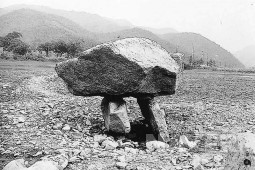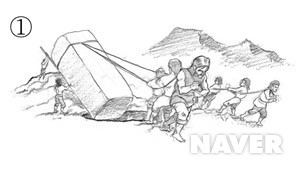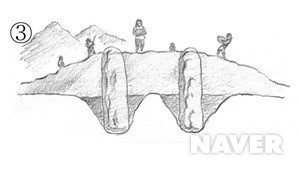GGHS 2019 Winter - Team 2
Write introduction about topic here.
Team
| No. | Team Topic | Teacher | Role | Name (Korean) | No. of Students |
|---|---|---|---|---|---|
| 2 | Dolmens of Ganghwa (강화의 고인돌) |
Evgeniia POLUMESTNAIA | Leader | 정가인 | 7 |
| Vice-Leader | 박진아 | ||||
| 홍지현 | |||||
| 심여빈 | |||||
| 홍연재 | |||||
| 류가람 |
Ganghwa and the Dolmen
In our team, main subject is 'Ganghwa and the Dolmen' . And Here sre some deveral topics that our group have investigated.
The Definition of Dolmens
Dolmen is literally a typical form of tomb during the Bronze Age. It means in Korean "Made from stone".
The kinds of Dolmens
- <Tokchasik Dolmen or Table Dolmen>
A table dolmen is a type of flat or table-shaped stone made of three or four large well-crafted stone bricks, composed of ' ㄷ' or 'ㅁ' letters on the ground, laid flat on top of it, and placed on top of it with a huge stone. Few burial objects have been found because the tomb was exposed to the ground and it is likely that the tomb was robbed early. [1] [2]
The Kinds Of Dolmen[3]
- <Gibansik Dolmen or Underground Dolmen>
It is called the "Sam style high mandol" or "Baduk style mandol." A tomb compartment is constructed underground and has three or four or more tombstones between it and the cover stone. Usually, they are distributed in places where large covering stones are easy to obtain and easy to transport, with no fixed format. [4]
The Kinds Of Dolmen[5]
- <Gaesoksik dolmen or Graveyard dolmen>
It is a type that is covered directly with a lid on a graveyard dolmen underground. Unlike other dolmen, have an ritual function. They were used as altars for years. [6]
The Kinds Of Dolmen[7]
The Process Of Making Dolmens
Process of Making Dolmen[8]
Select useful stones for Dolmen
Process of Making Dolmen[9]
Use round logs to move the heavy stones to a certain area where they will build dolmen
Process of Making Dolmen[10]
Build pedestal with stones and pile up the soil.
Process of Making Dolmen[11]
Put a covering stone on and remove the soil.
Role of Dolmen
Although there were many controversies over the function of the dolmen on the Korean Peninsula, it was confirmed in 1967 that the stone was made for the purpose of the tomb when the complete human bones were discovered at Hwangseok-ri Dolmen in Jecheon, North Chungcheong Province.
However, some argue that the tomb was not just a function of the tomb. Although there is no objection to the fact that the tomb functioned as a tomb, some argue that the stone was made as a function of an altar or tombstone in addition to the tomb. Claiming the function of the altar, the table dolmen might have served as an altar rather than a tomb, accourding to the fact that they are located higher than the surrounding area so that people can easily see, and the appearance of grandeur on the pedestal, and the structure of the pedestal, which is difficult to form a tomb.
In addition, in the case of a group of dolmen, sometimes the dolmen can be seen to be unusually large or different in direction than other dolmen, which is presumed to be a simple function that was built to reveal the authority and prestige of the tomb-building group.
Dolmens in Bugeun-ri, Ganghwa
On July 11, 1964, it was designated as Historic Site No.137 It belongs to a large group of northern-style dolmen discovered so far, which is 2.6 meters high on the ground and the size of a covering stone is 7.1 meters long and 5.5 meters wide, and consists of granite. The number of dolmen in the vicinity of the area is 10 and nine are included in the World Heritage except for the one not designated as 128. It is located in front of the village hall in Daechon-Burak, and there are only four more U.S. troops left. The pedestal has only two long stones, approximately north and south. There have been several surface surveys so far, but no academic excavation has been conducted yet. There is another destroyed dolmen next to the dolmen, which is gone and only the lid of the stone remains vertical. In addition, there are about 10 North and South flats left in Ganghwado Island, including Samgeori and Hadori.[12]
Why There Are Many Dolmen In Ganghwa
About 30,000 dolmens on the Korean Peninsula are 40 percent of the world's population. Among them, about 150 dolmen are located on Ganghwado Island. Why did so many dolmen come to Ganghwa? First, Ganghwado Island had a favorable geographical advantage to make dolmen. Many groups were formed because the abundant mountains and water made it easier to farm and live, and many dolmen were formed. Secondly, Ganghwado Island had a large number of rocks that were advantageous in making dolmen. The large number of rocks such as granite and polar rock were distributed, so it was easy to get them from other areas to make dolmen. [13]
The Worth Of Dolmens In Ganghwa
The economic value of dolmen
Currently, Ganghwa-gun is strengthening the tourism system by reusing the Dolmen site, a UNESCO World Heritage site, as a festive space. As a result, the value of the Dolmen site is being raised, and as the city was designated as a tourist city in 2018, many tourists are attracting and benefiting from the economic benefits. [14]
The historic value of dolmen
Dolmen are found all over the world, but many are found in Northeast Asia. Korea has so many dolmen that it is called the Dolmen Kingdom. There are 30,000 dolmen in South Korea and 15,000 dolmen in North Korea. This is equivalent to 40 percent of the world's dolmen. Although Korea has dolmen in many parts of the country, especially in the Honam region, Dolmen relics from Gochang, Hwasun and Ganghwa are listed as world heritage and are in such good condition that they are used as clues to the formation and development of Dolmen. Dolmen is also a giant stone culture, which is an important value in prehistoric sites. Dolmen itself is an important cultural heritage, but since various Bronze Age artifacts are also buried in tombs, it is very valuable for studying prehistoric history in Korea as well as in the world.
The Definition Of Dolmen[15]
Map(s)
Bugeunri Dolmen in Gnaghwa
Ganghwa History Museum
Network Graph(s)
- SAMPLE: VH2018_부석사reference.lst
- YOUR TEAM GRAPH: GGHS2019W_Team2.lst
References
- 인천광역시 문화유산 - 영문 해설문 포함 (한국학중앙연구원)
- ↑ (문화원형백과)
- ↑ (네이버캐스트)
- ↑ https://terms.naver.com/entry.nhn?docId=1639903&cid=43065&categoryId=43065
- ↑ (고고학사전)
- ↑ https://terms.naver.com/entry.nhn?docId=1745082&cid=49373&categoryId=49373
- ↑ (blog The meaning of History)
- ↑ https://terms.naver.com/entry.nhn?docId=1745083&cid=49373&categoryId=49373
- ↑ https://terms.naver.com/entry.nhn?docId=1582459&cid=47322&categoryId=47322
- ↑ https://terms.naver.com/entry.nhn?docId=1582459&cid=47322&categoryId=47322
- ↑ https://terms.naver.com/entry.nhn?docId=1582459&cid=47322&categoryId=47322
- ↑ https://terms.naver.com/entry.nhn?docId=1582459&cid=47322&categoryId=47322
- ↑ 강화부근리고인돌군 (한국민족문화대백과사전)
- ↑ ,강화역사박물관
- ↑ [1]
- ↑ https://terms.naver.com/entry.nhn?docId=1062222&cid=40942&categoryId=33374 고인돌








